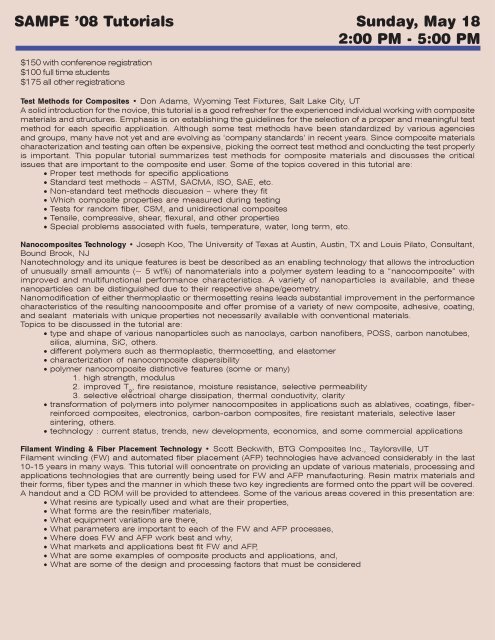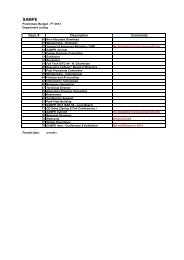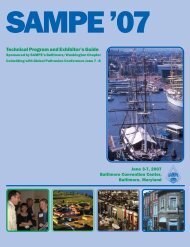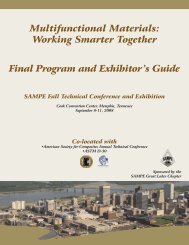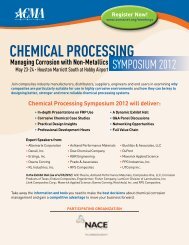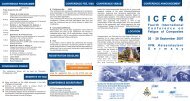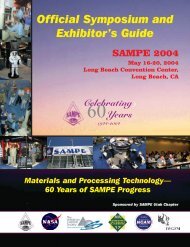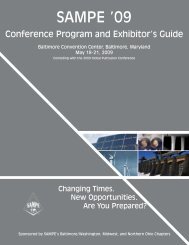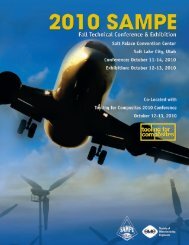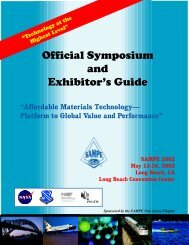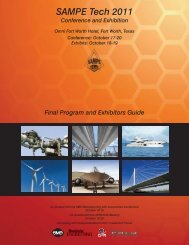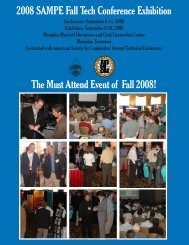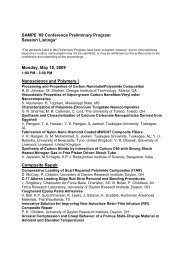Cincinnati Brochure - Sampe
Cincinnati Brochure - Sampe
Cincinnati Brochure - Sampe
You also want an ePaper? Increase the reach of your titles
YUMPU automatically turns print PDFs into web optimized ePapers that Google loves.
SAMPE ’08 Tutorials Sunday, May 18<br />
2:00 PM - 5:00 PM<br />
$150 with conference registration<br />
$100 full time students<br />
$175 all other registrations<br />
Test Methods for Composites • Don Adams, Wyoming Test Fixtures, Salt Lake City, UT<br />
A solid introduction for the novice, this tutorial is a good refresher for the experienced individual working with composite<br />
materials and structures. Emphasis is on establishing the guidelines for the selection of a proper and meaningful test<br />
method for each specific application. Although some test methods have been standardized by various agencies<br />
and groups, many have not yet and are evolving as ‘company standards’ in recent years. Since composite materials<br />
characterization and testing can often be expensive, picking the correct test method and conducting the test properly<br />
is important. This popular tutorial summarizes test methods for composite materials and discusses the critical<br />
issues that are important to the composite end user. Some of the topics covered in this tutorial are:<br />
• Proper test methods for specific applications<br />
• Standard test methods – ASTM, SACMA, ISO, SAE, etc.<br />
• Non-standard test methods discussion – where they fit<br />
• Which composite properties are measured during testing<br />
• Tests for random fiber, CSM, and unidirectional composites<br />
• Tensile, compressive, shear, flexural, and other properties<br />
• Special problems associated with fuels, temperature, water, long term, etc.<br />
Nanocomposites Technology • Joseph Koo, The University of Texas at Austin, Austin, TX and Louis Pilato, Consultant,<br />
Bound Brook, NJ<br />
Nanotechnology and its unique features is best be described as an enabling technology that allows the introduction<br />
of unusually small amounts (~ 5 wt%) of nanomaterials into a polymer system leading to a “nanocomposite” with<br />
improved and multifunctional performance characteristics. A variety of nanoparticles is available, and these<br />
nanoparticles can be distinguished due to their respective shape/geometry.<br />
Nanomodification of either thermoplastic or thermosetting resins leads substantial improvement in the performance<br />
characteristics of the resulting nanocomposite and offer promise of a variety of new composite, adhesive, coating,<br />
and sealant materials with unique properties not necessarily available with conventional materials.<br />
Topics to be discussed in the tutorial are:<br />
• type and shape of various nanoparticles such as nanoclays, carbon nanofibers, POSS, carbon nanotubes,<br />
silica, alumina, SiC, others.<br />
• different polymers such as thermoplastic, thermosetting, and elastomer<br />
• characterization of nanocomposite dispersibility<br />
• polymer nanocomposite distinctive features (some or many)<br />
1. high strength, modulus<br />
2. improved T g<br />
, fire resistance, moisture resistance, selective permeability<br />
3. selective electrical charge dissipation, thermal conductivity, clarity<br />
• transformation of polymers into polymer nanocomposites in applications such as ablatives, coatings, fiberreinforced<br />
composites, electronics, carbon-carbon composites, fire resistant materials, selective laser<br />
sintering, others.<br />
• technology : current status, trends, new developments, economics, and some commercial applications<br />
Filament Winding & Fiber Placement Technology • Scott Beckwith, BTG Composites Inc., Taylorsville, UT<br />
Filament winding (FW) and automated fiber placement (AFP) technologies have advanced considerably in the last<br />
10-15 years in many ways. This tutorial will concentrate on providing an update of various materials, processing and<br />
applications technologies that are currently being used for FW and AFP manufacturing. Resin matrix materials and<br />
their forms, fiber types and the manner in which these two key ingredients are formed onto the ppart will be covered.<br />
A handout and a CD ROM will be provided to attendees. Some of the various areas covered in this presentation are:<br />
• What resins are typically used and what are their properties,<br />
• What forms are the resin/fiber materials,<br />
• What equipment variations are there,<br />
• What parameters are important to each of the FW and AFP processes,<br />
• Where does FW and AFP work best and why,<br />
• What markets and applications best fit FW and AFP,<br />
• What are some examples of composite products and applications, and,<br />
• What are some of the design and processing factors that must be considered<br />
22


